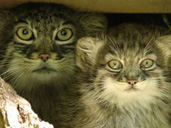First Pallas Cat kittens born at Cotswold Wildlife Park

Recently, Cotswold Wildlife Park introduced a brand new species to its collection; the majestic Pallas cat. We’re now delighted to announce that Hopalong & Tsara have just become parents with the birth of their first, as yet unnamed, litter!
Visitors to the Park’s website (www.cotswoldwildlifepark.co.uk) are being invited to name these adorable new kittens, one girl and one boy.
The new kittens are still very young but are adjusting nicely to their new home at the Park and can be seen in their exhibit opposite the Grey Owl enclosure.
The breeding season for these cats is relatively short due to the extreme climate in the cats’ native range. Oestrus only lasts between 26 and 42 hours, which is considerably shorter than in many other felids, so the fact that the adults have successfully bred in such a short period of time comes as good news to Curator, Jamie Craig, who said: “We are delighted that our pair of Pallas cats have reproduced so soon after arriving at the Park. This interesting and active species are sadly declining in numbers in their wild habitat and it is great to be contributing to their captive breeding programme. They are a particularly hardy species, ensuring our visitors always get a great view of the kittens and proud parents as they explore their exhibit, even in the worst of the English weather!”
Disappearing species
Pallas cats are considered rare and uncommon in Afghanistan, Pakistan, India and Iran and have sadly disappeared from much of their former range around the Caspian Sea. Although currently classified as Near Threatened, according to the IUCN Red List of Threatened Species*, it is feared the species could qualify as Vulnerable** in the near future.
High climbers
The Pallas cat occurs primarily in the central Asian steppe grassland regions of Mongolia, China and the Tibetan Plateau, where an elevational record of 5,050 metres was reported.
Additional information:
- It is believed that this species diverged from a leopard cat ancestor approximately 5.19 million years ago!
- They are named after the naturalist Peter Simon Pallas, who first described the species in 1776.
- Pallas's Cat is the oldest living species of a clade of felids.
- The cat also has an unusual threat display, raising and then quivering the upper lip on one side of the muzzle, displaying the large canine tooth
- Our male was named Hopalong due to the fact he broke his leg when he was a kitten, although his has no limp now.
- The collective term for a group of cats is clowder
Cotswold Wildlife Park is open daily from 10am.
- Cotswold Wildlife Park, Nr. Burford, Oxfordshire OX18 4JP
Explore Gloucestershire
3 September 2010
For further information.
OTHER NEWS
